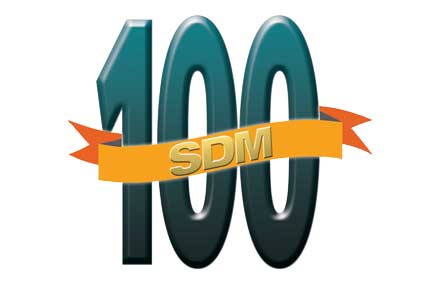Turning the corner on the 2010 economy was like telling off a friend who had it coming — you got to offload some of the poison, and you could move forward with a lesser burden. While the performance of the security industry in 2010 was less than stellar, there were some generally positive economic indicators in the first two quarters of 2011 that hold promise. Within the security industry itself, the strong attendance at ISC West last month and the optimistic “buzz” on the show floor, was evidence that things are going to get easier.
Leading the industry through this recovery is the SDM 100 — a ranking by recurring monthly revenue (RMR) of the largest security companies in the United States. SDM 100 companies earn their revenues from the sale, installation, service and monitoring of electronic security systems, such as intrusion and fire alarm, access control, video surveillance, and related low-voltage systems. Now in its 21st year of publication, the SDM 100 continues to prove that security is a significant concern of both homeowners and business executives, and that they are discovering ways to fund security systems and services.
“We are seeing signs of improvement as companies are committing to do projects that have been planned for some time. Our fourth-quarter 2010 and first-quarter 2011 new sales closed have shown improvement over the comparable periods of the prior year,” comments Intertech Security, ranked No. 53 on the SDM 100.
Like Intertech, other companies also were grateful to leave 2010 behind, describing the conditions as “average” at best. “It started a little slow and finished strong. Overall, I think the market was average,” describes Doyle Security Systems.
“The market for security system sales in 2010 was average to weak depending on the business segment. Continued poor economic conditions and tightened credit availability in the new construction segment of our business resulted in a decline in new system sales from that segment in most of our geographic markets,” according to No. 8 ranked Guardian Protection Services, adding, “Commercial and retrofit residential sales were up slightly over 2009, in addition to our expansion of our dealer business which helped drive the system growth in 2010.”
Yet, many of the industry’s largest security companies found 2010 to be extremely challenging.
“It required significantly more advertising expenditures to grow business as compared to earlier years. Customers are much more price-sensitive. [We faced] lower closing ratios and higher cancellation rates due to economic conditions. The new construction segment is almost non-existent,” says EMC Security.
With both sales and profits on a downslide in 2010 for many security businesses, one would not expect improvements in RMR or total annual revenue for the SDM 100 as a whole. Yet those improvements — 10 percent growth in RMR and 12 percent growth in total annual revenue in 2010 compared with 2009 — are primarily attributable to a significant number of companies that are ranked on the SDM 100 for the first time, causing the totals to surge.
The line that once separated traditional “security dealers” from “systems integrators” has become blurred as the former reaches higher into systems integration and the latter into lighter commercial markets. In addition, both types of channel companies are pursuing not only monitoring services, but “managed services” that also generate RMR. In light of these trends, SDM opened up the SDM 100 to all security companies that bill RMR. Readers of this year’s SDM 100 will find companies such as Niscayah, Kastle Systems, Ingersoll Rand (systems integration division), Intertech Security and Idesco Corp., among others — ranked for the first time among the more traditionally ranked security dealers.
In fact, Niscayah and Kastle Systems ranked in the top 15.
A shift due to ADT’s acquisition of Broadview caused several companies to advance a notch for the first time this year. Also important is the rebranding of APX Alarm to Vivint Inc. (which moved up from No. 6 to No. 4). Vivint posted a 56 percent increase in RMR between Dec. 31, 2009 and the same period in 2010.
Among the top 10 companies, all but one reported an increase in RMR. Among all 100 companies, 86 had better RMR; in some cases, it was a significant increase.
Growth by Segment & Technology
The greatest factor inhibiting growth in 2010 was, obviously, the lack of new construction. However, there were a few bright spots. “Some new construction is happening in the multifamily sector. Customers are beginning to make decisions more quickly and there is less emphasis on price,” EMC Security shares.
SDM 100 companies report other strong markets in 2010 were:
|
Many companies found most markets to be, in the words of SecureNet Alarm Systems Inc., “weak to average overall. Businesses were reluctant to commit to spending, particularly on larger projects. CCTV was best for growth.”
So say Valley Alarm, Custom Alarm, Per Mar Security and EPS Security, which in particular experienced 100 percent growth in 2010 in video surveillance sales.
JMG Security Systems had more Internet-based and network-based system bids. This correlates with data that shows a greater proportion of projects sold by SDM 100 companies in 2010 incorporated IP technology.
Business in fire alarm systems was mixed. For example, fire alarm sales were up for Yarnell Security Systems, No. 100; but for Mountain Alarm, No. 35, which specializes in fire, this was the worst-performing category.



